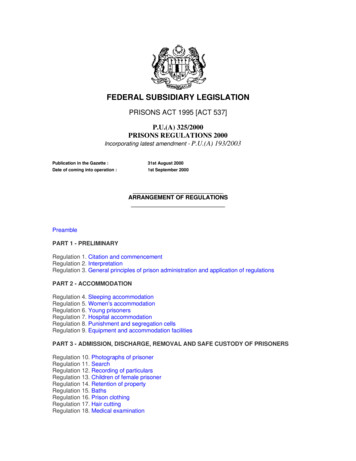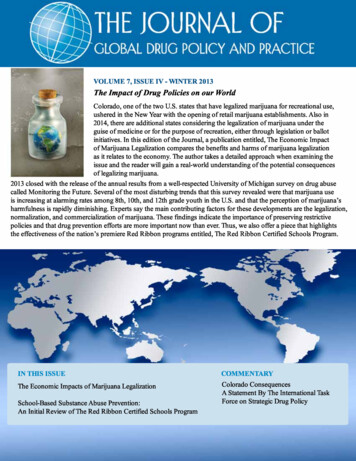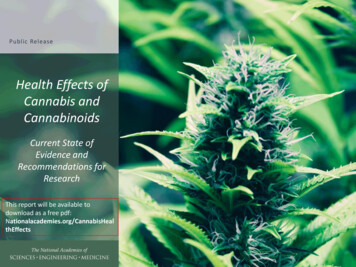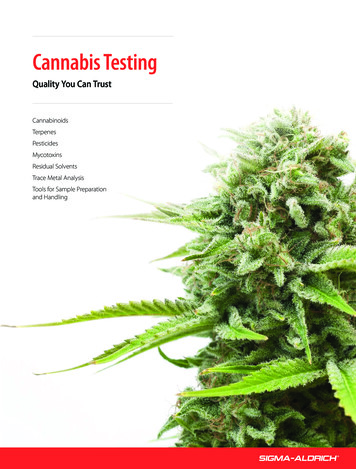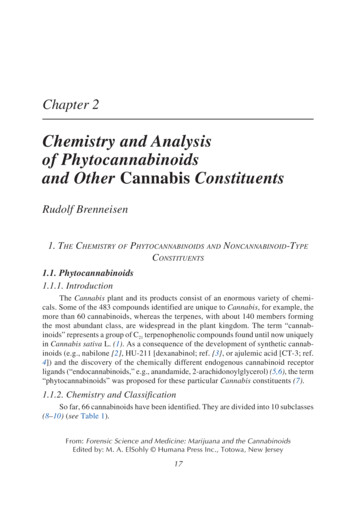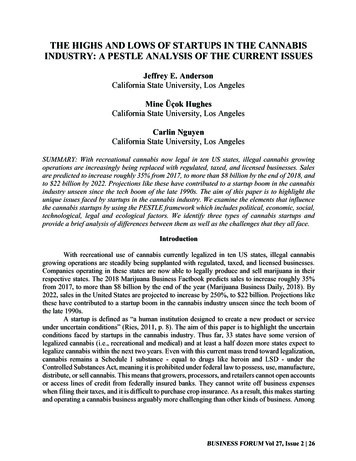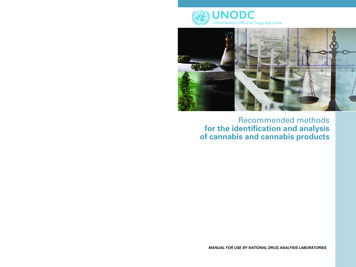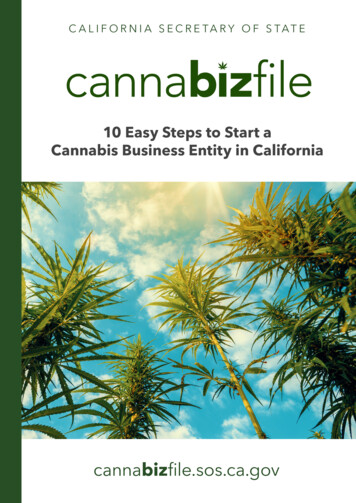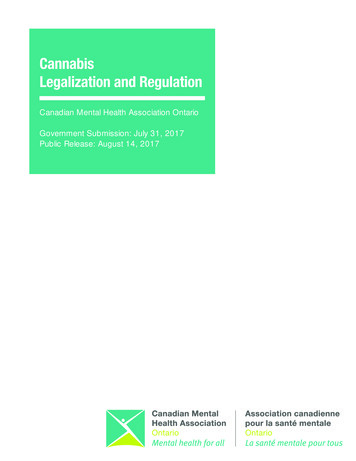
Transcription
CannabisLegalization and RegulationCanadian Mental Health Association OntarioGovernment Submission: July 31, 2017Public Release: August 14, 2017
About the Canadian Mental Health AssociationThe Canadian Mental Health Association (CMHA), which operates at the local, provincialand national levels across Canada, works toward a single mission: to make mental healthpossible for all. The vision of CMHA Ontario is a society that believes mental health is thekey to well-being. We are a not-for-profit, charitable organization funded by the OntarioMinistry of Health and Long-Term Care. Through policy analysis and implementation,agenda setting, research, evaluation and knowledge exchange, we work to improve thelives of people with mental health and addictions conditions and their families. As a leaderin community mental health and a trusted advisor to government, we actively contributeto health systems development through policy formulation and by recommending policyoptions that promote mental health for all Ontarians. CMHA Ontario works closely with30 local branches to serve nearly 100,000 people every year in communities across theprovince to ensure the quality delivery of services in the areas of mental health, addictions,dual diagnosis and concurrent disorders, which occur across the lifespan. Nationally,CMHA is the oldest, most extensive community mental health organization in Canada,celebrating 100 years in 2018.Photo by Brooke Cagle on Unsplash2
Executive SummaryAs the Government of Ontario moves towards legalizing and regulating cannabis, the Canadian Mental HealthAssociation (CMHA) Ontario Division and our local branches strongly advise an approach that considers publichealth as the primary objective. While legislation should address the addictions and mental health needs ofOntarians, legalization and regulation of cannabis provides an opportunity to broaden conversation aboutmental health and addictions. This is the time for rigourous public awareness campaigns that identify potentialconsumption harms, especially for youth and heavy users.Aside from a public health approach, the legalization and regulation of cannabis provides additional opportunitiesfor the Government of Ontario. The government can use this period of transition to further research cannabis useand examine the issue from a broader health equity lens. With these factors in mind, CMHA Ontario makes thefollowing recommendations:The Role of Community-Based Mental Health and Addictions Services The Government of Ontario should consult and partner with CMHAs and other communitybased mental health and addictions service providers to develop and immediately implement acomprehensive public awareness campaign regarding cannabis-associated health risks. Cannabis-related revenue should be allocated to mental health and addictions services. Enhance access to treatment and expand treatment options, specifically for youth and heavycannabis users. These include brief interventions for at-risk users, to more intensive interventionsfor heavy users. Provide further funding for new or existing services and community support programs, such asthose offered by local CMHA branches. Education for youth should be a key component of awareness initiatives. This should start as earlyas possible with age-appropriate content, created with the input of youth, and delivered by trainedfacilitators. Education for those that distribute cannabis to consumers should be considered, and CMHAOntario strongly encourages the use of a Cannabis Card program, similar to Ontario’s Smart Serveprogram.Minimum Age Requirements19 The minimum age to purchase cannabis should be 19 years of age. This should align with the legalage for purchasing alcohol in Ontario. Provide funding for extensive research examining the relationship between early onset use ofcannabis on brain development, particularly with mental health and addictions issues. Remove criminalization for personal possession of cannabis, especially for youth, and ensure thatthere is a system that would allow for social services, counseling and education instead of criminalsanctions for personal cannabis possession in small quantities (30g or less).3
Executive Summary Regulation of Sales Establish a regulatory agency, such as a Cannabis Control Board, to issue permits, production,sale, service and consumption of cannabis in Ontario. This agency would be similar to the Alcoholand Gaming Commission or the previous Liquor License Board of Ontario. Apply advertising and marketing restrictions to minimize the profile and attractiveness of cannabisproducts, similar to the restrictions on tobacco products. Ensure appropriate and reasonable pricing to deter consumers from purchasing cannabis throughillegal means. Limit availability by placing caps on retail density and hours of sale. Apply limits of allowable THC in products. Ensure revenues generated from cannabis sales are specifically directed to mental health andaddictions services. Distribution of cannabis should include the provision of cannabis education through theimplementation of a Cannabis Card program, similar to Ontario’s Smart Serve program.Road Safety Immediately develop a comprehensive public education strategy to send clear messages toOntarians that cannabis use causes impairment, and the best way to avoid driving impaired is notto consume. Ensure there is zero-tolerance for the consumption of cannabis in any motorized vehicle, includingboth drivers of the vehicle and any passengers. Consider the use of graduated sanctions ranging from administrative sanctions to criminalprosecution depending on the severity of the infraction for impaired driving due to cannabis use.Cannabis and the Justice System Prior to legalization, the Ontario Government should advocate with the Federal Government fordecriminalization of personal possession of cannabis in small quantities (30g or less). Youth offenses pertaining to cannabis possession should be decriminalized. Criminal sanctionsshould be replaced with alternatives such as fines, community service, mental health andaddictions service support and/or mandatory education.Where Cannabis Can Be Used 4Ensure that the cannabis laws are consistent with existing alcohol and smoking legislation, such asthe Liquor License Act and the Smoke Free Ontario Act.
IntroductionIn April 2017, the federal government introduced the Cannabis Act (Bill C-45), withthe goal of legalizing cannabis across the country by July 2018. The proposed Actcalls on provinces and territories to establish a framework to develop, implement andregulate certain aspects of cannabis legalization. It also recommends that legislationcontain minimum conditions so that a public health approach and safety objectivesare consistently addressed across the country. This allows provinces to adjust certainrules, such as distribution, possession, and raising the minimum age of purchase.CMHA Ontario commends the Government of Ontario for taking steps to engageOntarians around this issue, and will strive to be actively involved throughout theprocess. While cannabis legalization will impact many areas of society, we are pleasedthe discussion is viewed from a public health perspective. We strongly encourage thegovernment to take into consideration the crucial role of mental health and addictionsservices during this time of change.CMHA Ontario wishes to take this opportunity to provide our perspective andrecommendations, and engage in the consultation process. We are pleased to seesteps being taken to engage with Ontarians regarding this important issue. We wouldalso like to highlight the role community-based mental health and addictions agenciesplay in health promotion, education and service provision during this time of change.CMHA Ontario has consulted with our branches across the province to inform thisresponse through front-line community-based mental health and addictions serviceproviders who have a strong understanding of the issues facing their communities.CMHA Ontario and representatives from our branches are pleased to providefeedback, and welcome any further consultation on the matter.CMHAs would also welcome the opportunity to participate in any provincial, regionaland/or local planning tables that are convened to support the implementation of theCannabis Act and its regulations.Photo by Daniele Levis Pelusi on Unsplash5
The recommendations in our submission align with the CMHA NationalCannabis Policy Plan.1 Underpinning all of our recommendations arethe following themes:Focus on Public Health Approaches, Education and Harm ReductionTaking a public health approach, and the development of a corresponding strategy,is needed to improve the health of Ontarians by minimizing the harms associatedwith cannabis use, and should be a priority. The development and implementationof widespread public awareness campaigns to educate the public on the potentialharms and ways in which to minimize or reduce them. Public education is especiallyimportant for youth consumers.Focus on Mental Health and AddictionsCannabis legalization and regulation should be used as an opportunity to insertmental health and addictions initiatives into social standards. The creation of a newlegal framework regarding cannabis provides a unique opportunity to ensure thatmental health and addictions are placed on the federal and provincial radar, andthat conversations continue about the links between mental health, addictions andcannabis use.Focus on ResearchWhile it should be noted that the links between cannabis use and mental health hasbeen released by the Canadian Centre on Substance Use and Addiction and theCentre for Addiction and Mental Health, further research is still necessary. Continuedresearch efforts are needed to have an accurate understanding of the effects ofcannabis legalization on the health and wellness of Ontarians, and to strengthen theunderstanding of the links between cannabis use, mental health and addictions.Focus on Health EquityHealth equity is concerned with creating equal opportunities for health for all withreducing unjust differences in health among population groups. Currently, thereare systemic inequalities leading to the criminalization of marginalized groups forcannabis possession, which account for thousands of arrests and convictions everyyear.2 The criminalization of cannabis possession heightens health and social harms.Arrests for cannabis possession continue to take place, often disproportionatelyimpacting marginalized communities across the country. Given the plans forlegalization of cannabis in 2018, decriminalization of cannabis for simple possessionfor the general population should be considered immediately in the coming monthsprior to legalization.36Photo by Daniele Levis Pelusi on Unsplash
The Role of Community-Based Mental Health andAddictions Services in Responding to Cannabis UseThe upcoming legalization of cannabis in Canada is not without risks and may lead to an increase in use amongOntarians. While there are important lessons learned from other jurisdictions, no country has conducted nationallong-term studies on the impact of cannabis legalization and regulation on their population. As a result, both thefederal and provincial governments need to ensure there are safeguards in place, specifically as they relate tomental health and addictions service provision for cannabis users.CMHA Ontario recognizes that the need for mental health and addictions related supports may increase withcannabis legalization. Research shows a correlation between chronic cannabis use and psychiatric symptoms,especially if there is a personal or family history, or if cannabis use is initiated during mid-teen years.4 Harmreduction and access to resources to support Ontarians to make informed decisions about cannabis use is a keycomponent to ensure at-risk individuals are informed and able to access treatment. Public education initiativesare a key component to a health focused cannabis policy and should be a priority.CMHAs across Ontario are well positioned to support the Government of Ontario in protecting the health and wellbeing of Ontarians as these changes come into effect. We can support in the development of public awarenesscampaigns and community service initiatives. We can also provide mental health and addictions services andsupports to Ontarians facing cannabis addiction and misuse.CMHA Ontario recommends that all cannabis related revenue be divided and allocated for mental healthand addictions services. Currently, mental health and addictions receives approximately seven per cent offunding from the provincial health budget. CMHA Ontario supports the Mental Health Commission of Canada’srecommendation to increase spending on mental health and addictions to nine per cent of the overall provincialhealth care budget. This increase is especially necessary during this period of transition where Ontarians mayhave additional needs. The revenue generated from cannabis sales in the province may assist in meeting currentgaps in funding for the community-based mental health and addictions sector.Recommendations: The Government of Ontario should consult and partner with CMHAs and other community-based mentalhealth and addictions service providers across the province to develop and implement a comprehensivepublic awareness campaign regarding cannabis associated health risks. Enhance access to treatment and expand treatment options, specifically for youth and heavy cannabis users,ranging from brief interventions for at-risk users to more intensive interventions. Provide further funding for new or existing services and community support programs, such as those offeredby local CMHA branches, which are dedicated to heavy users of cannabis, and those who may be living withmental health and/or addictions issues.7
The Role of Community-Based Mental Health andAddictions Services in Responding to Cannabis UseRecommendations: Education for youth should be a key component of awareness initiatives. This should start early with ageappropriate content, created with the input of youth, including those who use cannabis, and delivered bytrained facilitators or peers. According to a survey by the Canadian Centre on Substance Use and Addictionon youth perceptions of cannabis, the legal consequences for cannabis possession were not clearlyunderstood and many were unaware of what was legal and illegal. It is imperative that youth be involved inplanning and education regarding legalization to make informed decisions about cannabis consumption. Education for those that distribute cannabis to consumers should be considered, and CMHA Ontario stronglyencourages the use of a Cannabis Card program, as discussed in the Regulating Cannabis Sales section ofthis document on page 11.Cannabis revenuesshould be dividedand allocatedon safeguardingpublic health25%For the development of programsdesigned to help cannabis users facingmental health and addictions problemsPublic awareness campaigns on thepotential impacts of cannabis use,particularly youth and heavy users2525%For research on the potential harmsand benefits of cannabis usage825%%For enforcement-related issues suchas the monitoring of advertisingPhoto by José Martín on Unsplash
Setting a Minimum Age for Purchase of CannabisCannabis is the most commonly used illegal drug in Canada, where more than 40 per cent of Canadians haveused cannabis in their lifetime, and about 10 per cent of the population having used within the past year.5 In June2016, a discussion paper developed by a nine-member Task Force on Cannabis Legalization and Regulationincluded the objective to protect young people by keeping cannabis out of the hands of children and youth.Despite this goal, research shows that cannabis use in Canada is most common between adolescents andyoung adults, with approximately 40 per cent of youth aged 18-29 in Ontario have used cannabis within thepast year.6 Because youth usage is higher than adults, persons under the age of 25 represent the populationof cannabis users who are charged with a cannabis possession offence.7 As a result, it is important to balanceissues of health and access, and ensure that there is an appropriate minimum age that does not encourageyoung people in Ontario to purchase cannabis through illegal means.Frequent cannabis use can harm a developing brain and there is no evidence that supports a specific age whencannabis use is safe for young people. The Canadian Medical Association reported support for a minimum ageof 21. The Ottawa Public Health Agency has stated that 25 should be the minimum age, given the potential forcannabis to have negative impacts on the developing brain.8 However, there are concerns that a higher minimumage may contribute to young people accessing cannabis from illegal sources. Establishing a higher minimum agestandard will be less effective in undermining the black market, and may leave youth both criminalized and relianton it.It is also important to consider the evidence that suggests that cannabis consumption may have negativeimpacts on mental health, including links to depression, anxiety and psychosis. The research regarding cannabisuse and the development of mental health issues varies, with some studies revealing correlations, particularly withyouth and the development of psychotic disorders.9No matter the mental health issue or illness of concern, evidence-based research providing a direct causalrelationship to cannabis use is lacking. While some mental illnesses may have stronger links to cannabis usethan others, more research is needed in this area. However, it should be noted that “cannabis use has potentiallyadverse effects among those who are already vulnerable to mental illnesses, including teens.”10 As a result,education and health promotion, and access to community-based mental health and addictions supports is anessential component when considering cannabis use with youth.The Cannabis Act states that people must be 18 years of age to have and buy cannabis, but provinces will beallowed to raise the minimum age. In considering the numerous health and social implications, as well as thecurrent evidence, CMHA Ontario recommends the minimum age to purchase cannabis be 19 years.9
Setting a Minimum Age forPurchase of CannabisRecommendations: The legal age to purchase cannabis, at aminimum, should align with the legal age forpurchasing alcohol in Ontario: age 19. In order to reduce the potential harms, cannabiseducation is a necessary component in thelegalization and regulation process. CMHAOntario recommends developing a robust publiceducation campaign to increase public awarenesssurrounding the potentially negative impacts ofearly onset cannabis use on the maturing brain. Provide funding for extensive research examiningthe relationship between early onset use ofcannabis on brain development, particularly withmental health and addictions issues. Allocate funding for the development of morewidespread community resources for youth inorder to ensure mental health and addictionssupports are accessible when they are needed. The Government of Ontario should advocate withthe Federal Government to remove criminalizationfor simple possession of cannabis, especiallyfor youth. This would limit interactions betweencannabis users and the criminal justice systemand reduce the burden on the system, acrosspolicing, courts and corrections services. CMHArecommends further research into a model similarto the Portugal’s decriminalization policy foryoung people that would allow for social services,counseling and education instead of criminalsanctions for underage cannabis possession.10In 2001, Portugal decriminalized low-level possessionand use of all substances for personal consumptionand took a health centred approach to a growingconcern with addiction in the country by also investingin treatment and addictions services. Outcomesincluded: fewer people involved in the justice systemfor drug possession, reduced drug induced deaths,decrease in the rates of HIV/AIDS and an increasein people receiving treatment. In addition, Portugal’sMinistry of Health also implemented the Commissionfor the Dissuasion of Drug Addiction, made up ofhealth care providers, which ensured that those foundin possession of illicit drugs and have a substance useissue were provided alternatives to the justice system,including: fines, education, options for treatment orcommunity service.11
Regulating Cannabis SalesAccording to the Centre for Addiction and Mental Health, it is unlikely that legalization alone will reduce the healthrisks and harms of cannabis. It is necessary to also regulate sales in order to mitigate risks and ensure that thereis a comprehensive plan for selling and distributing cannabis. Health and safety rules, training requirements forstaff and regulation regarding the production and sale of cannabis should be key components.Much like the Alcohol and Gaming Commission, or the previous Liquor License Board of Ontario, CMHAOntario recommends that Ontario establish a Cannabis Control Board to be the regulatory agency responsiblefor issuing permits and regulating the production, sale, service and consumption of cannabis in Ontario topromote responsible use. Such a regulatory agency must also oversee the production of cannabis to establishand ensure quality control, in a similar fashion to Vintners Quality Alliance (VQA), which is the provincial authorityon the standards for the production of wine in Ontario. CMHA Ontario believes that in order to provide a healthfocused cannabis control system, the government must establish a monopoly on sales where revenues from thesale of cannabis are directed to mental health and addictions services and supports. Control board entities witha social responsibility mandate provide an effective means of controlling consumption and reducing harms, andthis should be prioritized over the interests of the private sector cannabis industry.12 Furthermore, CMHA Ontariosupports the strict advertising regulations and limitations for the cannabis industry as we believe that public healthinterests must take precedence over the interests of the cannabis industry.CMHA Ontario supports the proposed Cannabis Card program, as put forth by CMHA National’s CannabisPolicy Plan. A Cannabis Card program could operate in a similar manner to the Ontario Smart Serve program. ACannabis Card program could provide training to cannabis retail staff to inform customers of the potential harmsand benefits of cannabis, including mental health and addictions information, road safety, and the current lawsand regulations. The program would ensure safe sale of cannabis, create informed staff and spread knowledgeto cannabis users.Recommendations: Apply advertising and marketing restrictions to minimize the profile and attractiveness of cannabis products(i.e.: sponsorships, endorsements or branding) similar to the restrictions on promotion of tobacco products. Ensure appropriate and reasonable pricing to deter consumers from purchasing cannabis through illegalmeans. Limit availability by placing caps on retail density and limiting hours of sale. Distribution of cannabis should include the provision of cannabis education to patrons through theimplementation of a Cannabis Card program, similar to Ontario’s Smart Serve program. Provide funding for extensive research examining the relationship between early onset use of cannabis onbrain development, particularly with mental health and addictions issues.11
Regulating Cannabis SalesCannabis products should require plain packaging that includes the following information:Company NameTHC AmountStrain NameiPriceCompStrainPriceCBD AmountWarning Labelany NNameame; ingredientsΔ 9 THCMax: XCBD MX.X%ax: X.XX%Please note: The image above is only to illustrate the type of information oncannabis products. It is not intended for commercial use.CBD is the abbreviation for Cannabidiol, the cannabinoid second only to THC, or Tetrahyrdocannabinol, whichis the principle psychoactive chemical in most cannabis. Recently, research has shown CBD to have analgesic,anti-inflammatory, and anti-anxiety properties without limited psychoactive effects that THC provides.i12
Road SafetyFrom a public health perspective, the impact of cannabis on the operating of motor vehicles may be the mostconcerning in the debate on cannabis legalization. Data from 2012 revealed that 2.6 per cent of drivers discloseddriving after consuming cannabis within the past year, translating to an estimated 10.4 million trips on Canadianroads, with youth aged 18-19 most likely to report driving after using cannabis.13Despite the concerns regarding impairment and an increased risk in accidents, cannabis remains difficult todetect and accurately measure. In addition, current cannabis testing can only detect the presence of THC in thebody, but may not necessarily correspond with actual impairment. CMHA Ontario also notes that the distinctionbetween the effects of THC and CBD is necessary for effective policy development on road safety and impaireddriving, especially as it relates to medical cannabis users.Because the technology to detect an individual’s level of impairment due to cannabis is still in development at thistime, CMHA Ontario recommends a zero-tolerance policy for cannabis consumption in any motorized vehicle inorder to ensure road safety during this time of transition. A zero-tolerance policy would include both the driver ofthe motorized vehicle, as well as any passengers in the car. It is important that a clear message be sent to thepublic as soon as possible regarding zero tolerance for impaired driving due to cannabis use. Significant progresshas been made in this area by public awareness campaigns regarding the dangers of alcohol impaired driving byorganizations such as Mothers Against Drunk Driving (MADD). CMHA Ontario urges the provincial government toprioritize public awareness and education campaigns to accurately reflect the severity of the potential impacts ofcannabis impaired driving prior to cannabis legalization.As such, CMHA Ontario offers the following recommendations, which are largely a replication of therecommendations made by the Task Force regarding cannabis-impaired driving, and CMHA National’s CannabisPolicy Plan.14Recommendations: Invest immediately and work to develop a comprehensive public education strategy to send a clear messageto Ontarians that cannabis use causes impairment, and the best way to avoid driving impaired is not toconsume. The strategy should also inform Ontarians of:lThe dangers of cannabis-impaired driving, with special emphasis on youthlThe applicable laws and the ability of law enforcement to detect cannabislThe increased risk of combining cannabis and alcohol use Ensure there is zero-tolerance for the consumption of cannabis in any motorized vehicle, including bothdrivers of the vehicle and any passengers. The government should consider the use of graduated sanctions ranging from administrative sanctions tocriminal prosecution depending on the severity of the infraction for impaired driving due to cannabis use.13
Cannabis and the Justice SystemDecriminalization is the removal of criminal penalties for drug law violations, usually possession for personal use ofsmall quantities. Benefits of this model include a reduction in the number of people arrested and incarcerated, anincreased uptake into substance abuse treatment and protecting people from the wide range of health and socialconsequences of a criminal conviction.15CMHA Ontario supports the decriminalization of cannabis for personal possession of small quantities (30g orless) prior to legalization. In a July 2017 meeting of the Council of the Federation, provincial premiers statedthat the federal government must provide provinces more clarity and guidance surrounding the legalization ofcannabis, and they may need more time for proper consultation, planning and implementation, which woulddelay the timeline for legalization.16 During this time, many individuals may become in conflict with the law forpersonal possession of cannabis. In the interim period prior to legalization, CMHA Ontario is recommending thedecriminalization of personal possession of small quantities of cannabis (30g or less).Issues of equity are at the core of the proposed decriminalization for cannabis possession prior to legalization.In 2016, there were approximately 55,000 cannabis-related offenses, with 81 per cent for possession.17 It isestimated that there is an arrest for cannabis possession approximate every nine minutes in Canada. Accordingto Bill Blair, Parliamentary Secretary to the Minister of Justice and Attorney General of Canada, a disproportionatenumber of those arrests are among “minority communities, Aboriginal communities, and those in the mostvulnerable neighbourhoods.”18 Numerous advocates, politicians and health care practitioners, including Toronto’sMedical Officer of Health, have also aligned for this approach and are calling for the decriminalization of cannabisuse prior to the 2018 legalization date.19In addition to decriminalization of cannabis possession prior to legalization, CMHA Ontario also encouragesthe government to consider the Task Force recommendation regarding youth and supports the view thatcriminalization of youth should be avoided where possible. Currently, the legal treatment of cannabis can beunclear due to a wide allowance for police discretion. A first conviction for youth with possession of less than30 grams of cannabis is a fine of 1,000, six months in jail, or both, and can result in a criminal record.20 CMHAOntario recommends that alternatives to criminalization be considered in cases of youth found in possession ofcannabis.Research consistently reveals that increasing sanctions will not reduce crime, and
the Liquor License Act and the Smoke Free Ontario Act. Cannabis and the Justice System Prior to legalization, the Ontario Government should advocate with the Federal Government for decriminalization of personal possession of cannabis in small quantities (30g or less). Youth offenses pertaining to cannabis possession should be .
